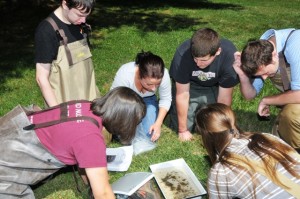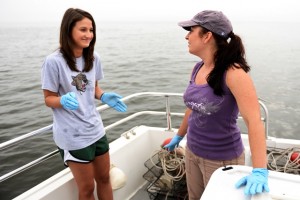For Megan Rothenberger, the best way to coach students as they put the scientific method into action is through course-based research.
The students in her advanced biology course Environmental Issues in Aquatic Ecosystems tackle a semester-long research project that not only exposes them to the rigors of real-world research, but teaches them how to communicate those results effectively.

Professor Megan Rothenberger and students in her Environmental Issues in Aquatic Ecosystems course use macroinvertebrates and diatom assemblages as indicators of water quality at urban and forested sites along the Bushkill Creek.
Students are divided into two teams to study potential management problems in the local Sullivan Park constructed wetland: the presence of aggressive invasive plant species and seasonal algal blooms. The students learn more about the capacity of constructed wetlands to treat storm water and improve water quality.
Rothenberger teaches about sampling and analytical techniques and then the students put what they learned to the test. They collect data and compose an environmental assessment report detailing their findings and proposing potential management strategies to the City of Easton.
“The knowledge gained through environmental monitoring and research is often applied by policymakers, park managers, and businesses to construct best management practices, so we must be able to explain our scientific findings in an accessible way,” says Rothenberger, assistant professor of biology.

Sarah Woodruff ’15 is working with Professor Rothenberger on her honors project focusing on invasive crab species in the Raritan Bay System. Photo by Bill Stank, PhotoSynthesis Photography
Lecture and research go hand in hand. In the classroom, students gain a strong foundation in topics such as nutrient pollution, algal blooms, invasive species, and wetlands loss. One group is tasked with characterizing the wetland plant community and documenting the current mean percentage coverage of invasive species while the second group assesses the relationship between nutrient concentrations and ratios and the development of algal blooms in the retention pond.
The Sullivan Park experience motivates many students to pursue more extensive long-term study outside class. In fact, the majority of Rothenberger’s research students approached her about additional opportunities after taking one of her classes.
The interdisciplinary module includes civil and environmental engineering professors David Brandes and Art Kney. Brandes and a team of students installed a wetlands habitat at the park by mitigating a serious water runoff problem and planting native vegetation. Their efforts helped the city earn the 2014 Green Park of the Year award for the renovations.

